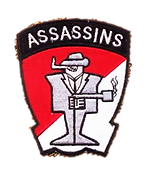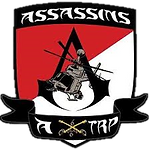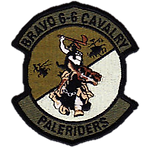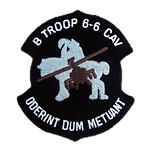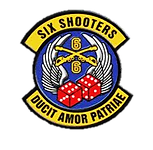
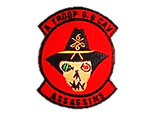
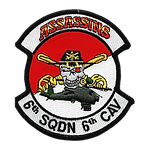
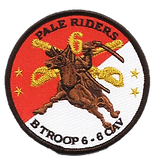
6th Squadron, 6th Cavalry
Six Shooters
Germany
(1990 - 2002)
On 6 June 1990 (the Sixth day of the Sixth month), the squadron activated at Fort Hood, Texas. After an intensive training program and being designated as Combat Ready, with enough combat power to destroy an enemy tank division, the squadron left for Germany. The arrival of the squadron saw its sister squadron (2-6 CAV) deploying to Saudi Arabia for Operations DESERT SHIELD and DESERT STORM. Also marked for deployment, the squadron trained while performing security operations in Germany. The violent and short duration of the war saw the 6th Squadron still in Germany at the war's end. Saddam Hussein, unable to defeat the force he faced, turned against the Kurdish people in Northern Iraq. He systematically began to eliminate them. The 6th Squadron received the call to deploy to Northern Iraq and stop the senseless slaughter of the Kurdish people. Within 96 hours the Squadron left Germany in the first self-deployment by an AH-64 Attack Helicopter Squadron. Covering 5 countries, 2 continents, and 3,000 miles in just 4 days the Squadron established and controlled a 2,500 square mile security zone, as part of Operation PROVIDE COMFORT allowing the Kurdish people to return to their homes. October 1991 saw the redeployment of the Squadron to Illesheim, Germany. Subsequently, the Squadron was the first Squadron in the US Army to complete the Aviation Restructuring Initiative (ARI) transition.
In April of 1996, C Troop (+), 6th Squadron, 6th Cavalry deployed to Camp Hampton, Bosnia-Herzegovina in support of Operation JOINT ENDEAVOR and the First Brigade Combat Team of the First Armored Division.
Demonstrating the Army's commitment to both accomplishing its missions and maintaining high standards of safety, a team of civilian contractors and soldiers completed modifications to V Corps' fleet of Apache helicopters in June 1997, and did so without impairing the aircraft's use in meeting mission requirements in Operation JOINT GUARD. What made USAREUR's Apache project particularly critical and challenging was the requirement to make the changeover while half of V Corps' Apache fleet was deployed to Tuzla, Bosnia-Herzegovina and engaged in real-world operations. The contract team from Sabreliner Corporation in St. Louis changed 127 gas-generator (GG) rotors on 83 AH-64 Apache helicopters, starting 19 April 1997 and ending 6 June 1997. 6th Squadron, 6th Cavalry Apaches received new GG rotors at its base in Illesheim. In order for the 3-person contract team to work at maximum speed, aviation mechanics set their other missions aside and worked from 0600 to 2100 for 5 days, removing the engines, replacing them when the contract team completed the modification and performing required maintenance operations checks.
In 1998, the entire squadron deployed to Bosnia again in support of Operation JOINT GUARD and JOINT FORCE. They formed the nucleus of Task Force Sixshooter, as part of the 1st Armored Division for 4 months. The Task Force assumed 2 missions from 2 separate battalions, flying over 5000 hours, and maintained all training proficiency.
Less than 6 months after the redeployment from Bosnia the call for duty rang again, this time in support of Operation ALLIED FORCE. Recognized as the most combat-ready Apache unit in Europe, the squadron was chosen to spearhead the deployment and prepare for combat missions against the Federal Republic of Serbia. Upon capitulation of Serbian forces, one-third of the squadron deployed to Skopje, Macedonia where they conducted peacekeeping operations in the war-torn area of Kosovo in support of Operation JOINT GUARDIAN.
Two 11th Aviation Regiment soldiers were killed in Albania 05 May 1999, following the crash of their AH-64 Apache helicopter. The crash occurred about 75 kilometers northeast of the Tirana-Rinas Airport during a training mission in support of Operation ALLIED FORCE. The aviators were identified as Chief Warrant Officer 3 David A. Gibbs, 38, from Ohio and Chief Warrant Officer 2 Kevin L. Reichert, 28, from Wisconsin. Both were assigned to C Troop, 6th Squadron, 6th Cavalry Regiment at Illesheim, Germany.
The crash of the 2-person helicopter occurred about 1:30 AM. A security element secured the crash site and an Explosive Ordnance Disposal team aided in the recovery effort.
A June 1999 review of aviators in the 2-6 CAV and 6-6 CAV squadrons found that two-thirds of the assigned aviators had fewer than 500 flying hours, and none was Night Vision Goggles-qualified in the co-pilot gunner position.
In early June 2001, 6-6 CAV gathered in its hangar on Storck Barracks in Illesheim and the troopers of this historic unit officially cased their colors in anticipation of their move to Fort Hood, Texas. The timing of the casing was no coincidence. For it was exactly 11 years to the day they stood up the unit with the then state-of-the-art AH-64A Apache helicopter. The unit was headed back to Fort Hood to be trained in the newest model of the Apache at the time, the AH-64D Longbow Apache. The unit stood up in October 2001 at Fort Hood, Texas, after pilot training at Fort Rucker, Alabama. Their return back to Illesheim was expected to occur within the July-September 2002 time frame.
Illesheim was the first location in USAREUR to see a change with the introduction of the AH-64D Longbow. 6-6 CAV troopers based there as part of the 11th Aviation Regiment, left in Summer 2001 for a year of training at Fort Hood, Texas, with 24 AH-64A Apaches.
The squadron was the first unit in USAREUR to reflect the reorganization of assets. Previously composed of 3 companies, each with 8 Apaches, 6-6 CAV subsequently had 3 companies with 7 Longbows each, the new Army-wide standard for corps aviation assets. With no immediate changes in manpower or maintenance assets, the command had a greater amount of assets to focus on the enhanced aircraft.
On 22 July 2002, 22 x AH-64D Apache Longbow helicopters, assigned to 6-6 CAV flew in mass formation to their home airfield in Illesheim, Germany. The helicopters had arrived at the port of Antwerp the previous week encased in a protective cocoon of shrink-wrapped plastic. Once accounted for and inspected, mechanics and crew chiefs from Troop D began reassembly of the Longbows. Following the reassembly process, the helicopters were test-flown before being moved to Illesheim. The arrival of the Apache squadron marks its return from Fort Hood, Texas, where the squadron had spent a year becoming familiar with the helicopters as they were upgraded from AH-64A models.
A report in the 16 October 2002 European Stars and Stripes reported that elements of V Corps had deployed to Kuwait, ahead of the command element that was not due to arrive in the region for a couple of weeks. 6-6 CAV was thought to have arrived in Kuwait on 15 October 2002. However, subsequent reports and information from sources have made cast some doubt as to whether or not this deployment even took place, leaving one to conclude that it most likely did not take place. It later turned out to be accurate when the squadron was deployed as part of Operation IRAQI FREEDOM in March 2003. 6-6 CAV and other deployed elements of V Corps left Iraq in March 2004.
In 2005 6-6 CAV became part of the push to transform the US Army to the newly developed modular force structure. A part of the transformation saw the inactivation of the 11th Aviation Regiment, later to be followed by all of V Corps. 1-10 AVN was reflagged as 6-6 CAV and reactivated 23 January 2007 as part of the transformed 10th Combat Aviation Brigade, assigned to the 10th Mountain Division (Light Infantry).
In June 2006, 6-6 CAV deployed to Afghanistan in support of OEF.
In November 2008, 6-6 CAV deployed to northern Iraq in support of OIF. Following the squadrons return in June 2009, elements from 6-6 CAV integrated with C, 1-10 ATK Blue Max, combining into one dual-airframe flight company, the only one like it in the Army. It consisted of 6 OH-58D and 6 AH-64D helicopters.
In early 2010, the squadron was task organized as Task Force Six Shooters and in October deployed to Afghanistan in support of Operation ENDURING FREEDOM XI. Assigned to Jalalabad Airfield, the task force was responsible for the highly kinetic N2KL region. The task force performed exceptionally well and amassed over 1,000 enemies KBA (killed-by-air), and earned many Distinguished Flying Crosses and Air Medals for Valor. Task Force Six Shooters also flew more than 30,000 hours, participated in more than 140 assaults, transported more than 50,000 passengers, and delivered in excess of 7 million lbs. of cargo. Upon the task forces return to Fort Drum, New York, in October 2011, the task force was presented both the Parker Award and the AAAA Outstanding Aviation Unit of the Year - only the second time that an aviation unit had won both awards in a single year.
The squadron remained organized as a task force until 28 March 2014, when B and D Troops reintegrated. Training was the primary focus from 2012 until 2015. JRTC was conducted in August 2014, with the last main body flight arrival back to Fort Drum on 8 September 2014.
In April thru May 2015, the squadron completed it's annual aerial gunnery. In late 2015, the squadron deployed to Korea.
On 29 August 2016, the squadron uncased its colors at Fort Drum, having returned from Korea.
On 15 September 2016, the squadron transitioned to a Heavy - Attacked Reconnaissance Squadron (HARS). In December, the Squadron completed aerial gunnery. This was the first major training event since transitioning to Apache and Shadow aircraft.
In March 2017, the squadron, with its AH-64s, deployed to JRTC for its Culminating Training Exercise (CTE). On 28 September 2017, the squadron cased its colors for a nine-month rotation to Korea. In October the squadron conducted its RIP/TOA ceremony with its sister squadron (1-6 CAV).
